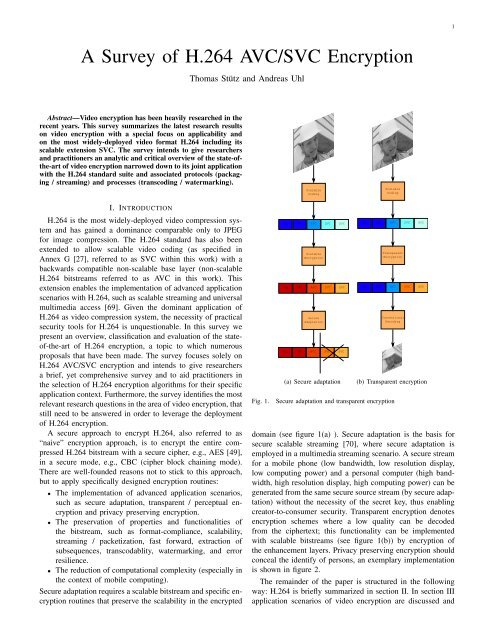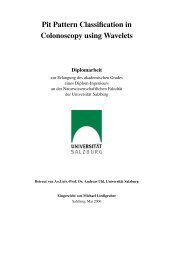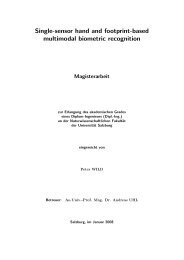A Survey of H.264 AVC/SVC Encryption
A Survey of H.264 AVC/SVC Encryption
A Survey of H.264 AVC/SVC Encryption
You also want an ePaper? Increase the reach of your titles
YUMPU automatically turns print PDFs into web optimized ePapers that Google loves.
1A <strong>Survey</strong> <strong>of</strong> <strong>H.264</strong> <strong>AVC</strong>/<strong>SVC</strong> <strong>Encryption</strong>Thomas Stütz and Andreas UhlAbstract—Video encryption has been heavily researched in therecent years. This survey summarizes the latest research resultson video encryption with a special focus on applicability andon the most widely-deployed video format <strong>H.264</strong> including itsscalable extension <strong>SVC</strong>. The survey intends to give researchersand practitioners an analytic and critical overview <strong>of</strong> the state-<strong>of</strong>the-art<strong>of</strong> video encryption narrowed down to its joint applicationwith the <strong>H.264</strong> standard suite and associated protocols (packaging/ streaming) and processes (transcoding / watermarking).ScalableCodingScalableCodingI. INTRODUCTION<strong>H.264</strong> is the most widely-deployed video compression systemand has gained a dominance comparable only to JPEGfor image compression. The <strong>H.264</strong> standard has also beenextended to allow scalable video coding (as specified inAnnex G [27], referred to as <strong>SVC</strong> within this work) with abackwards compatible non-scalable base layer (non-scalable<strong>H.264</strong> bitstreams referred to as <strong>AVC</strong> in this work). Thisextension enables the implementation <strong>of</strong> advanced applicationscenarios with <strong>H.264</strong>, such as scalable streaming and universalmultimedia access [69]. Given the dominant application <strong>of</strong><strong>H.264</strong> as video compression system, the necessity <strong>of</strong> practicalsecurity tools for <strong>H.264</strong> is unquestionable. In this survey wepresent an overview, classification and evaluation <strong>of</strong> the state<strong>of</strong>-the-art<strong>of</strong> <strong>H.264</strong> encryption, a topic to which numerousproposals that have been made. The survey focuses solely on<strong>H.264</strong> <strong>AVC</strong>/<strong>SVC</strong> encryption and intends to give researchersa brief, yet comprehensive survey and to aid practitioners inthe selection <strong>of</strong> <strong>H.264</strong> encryption algorithms for their specificapplication context. Furthermore, the survey identifies the mostrelevant research questions in the area <strong>of</strong> video encryption, thatstill need to be answered in order to leverage the deployment<strong>of</strong> <strong>H.264</strong> encryption.A secure approach to encrypt <strong>H.264</strong>, also referred to as“naive” encryption approach, is to encrypt the entire compressed<strong>H.264</strong> bitstream with a secure cipher, e.g., AES [49],in a secure mode, e.g., CBC (cipher block chaining mode).There are well-founded reasons not to stick to this approach,but to apply specifically designed encryption routines:• The implementation <strong>of</strong> advanced application scenarios,such as secure adaptation, transparent / perceptual encryptionand privacy preserving encryption.• The preservation <strong>of</strong> properties and functionalities <strong>of</strong>the bitstream, such as format-compliance, scalability,streaming / packetization, fast forward, extraction <strong>of</strong>subsequences, transcodablity, watermarking, and errorresilience.• The reduction <strong>of</strong> computational complexity (especially inthe context <strong>of</strong> mobile computing).Secure adaptation requires a scalable bitstream and specific encryptionroutines that preserve the scalability in the encryptedFig. 1.SPS PPS <strong>AVC</strong> <strong>SVC</strong> <strong>SVC</strong>Scalable<strong>Encryption</strong>SPS PPS <strong>AVC</strong> <strong>SVC</strong> <strong>SVC</strong>SecureAdaptationSPS PPS <strong>AVC</strong> <strong>SVC</strong> <strong>SVC</strong>(a) Secure adaptationSPS PPS <strong>AVC</strong> <strong>SVC</strong> <strong>SVC</strong>Transparent<strong>Encryption</strong>SPS PPS <strong>AVC</strong> <strong>SVC</strong> <strong>SVC</strong>ConventionalDecoding(b) Transparent encryptionSecure adaptation and transparent encryptiondomain (see figure 1(a) ). Secure adaptation is the basis forsecure scalable streaming [70], where secure adaptation isemployed in a multimedia streaming scenario. A secure streamfor a mobile phone (low bandwidth, low resolution display,low computing power) and a personal computer (high bandwidth,high resolution display, high computing power) can begenerated from the same secure source stream (by secure adaptation)without the necessity <strong>of</strong> the secret key, thus enablingcreator-to-consumer security. Transparent encryption denotesencryption schemes where a low quality can be decodedfrom the ciphertext; this functionality can be implementedwith scalable bitstreams (see figure 1(b)) by encryption <strong>of</strong>the enhancement layers. Privacy preserving encryption shouldconceal the identify <strong>of</strong> persons, an exemplary implementationis shown in figure 2.The remainder <strong>of</strong> the paper is structured in the followingway: <strong>H.264</strong> is briefly summarized in section II. In section IIIapplication scenarios <strong>of</strong> video encryption are discussed and








